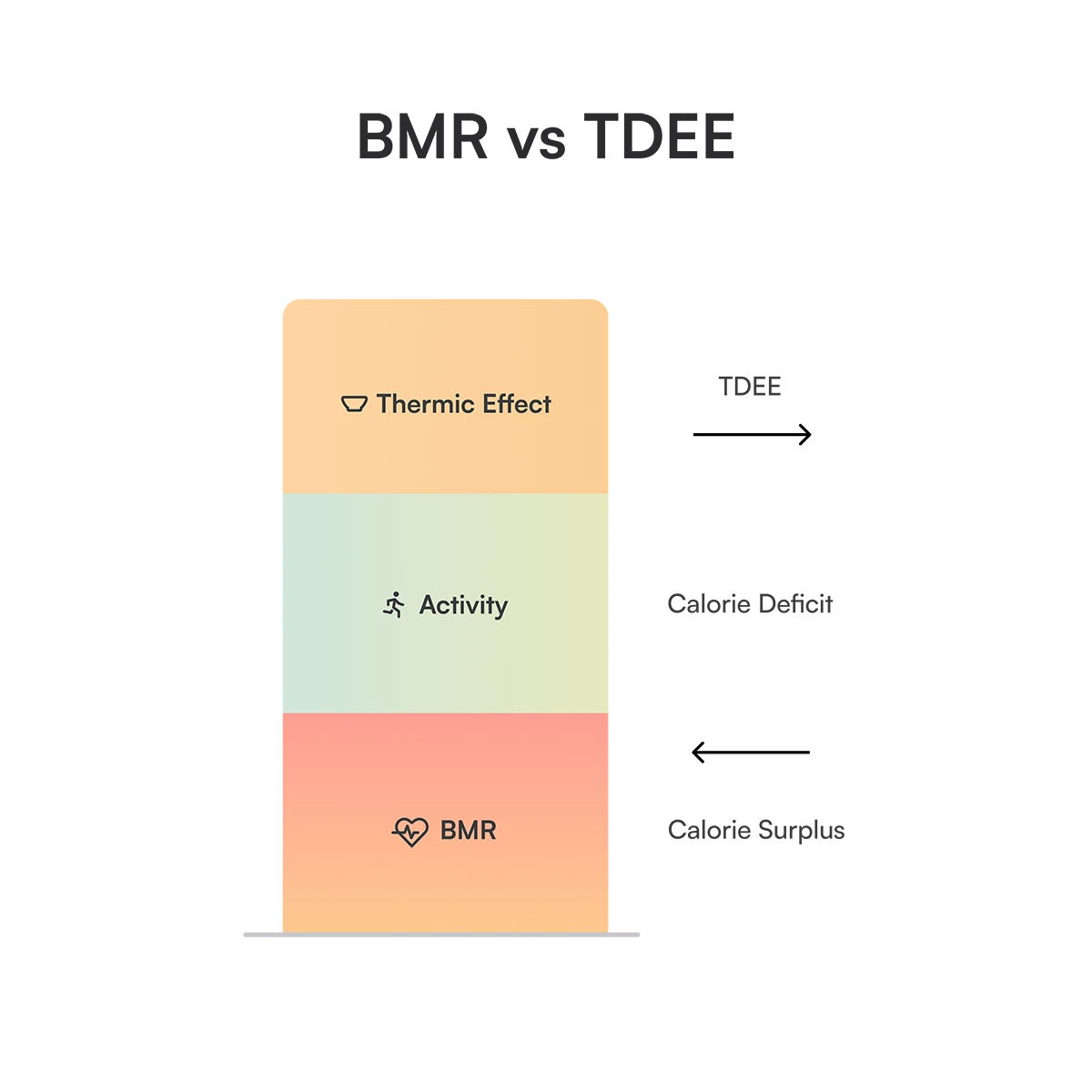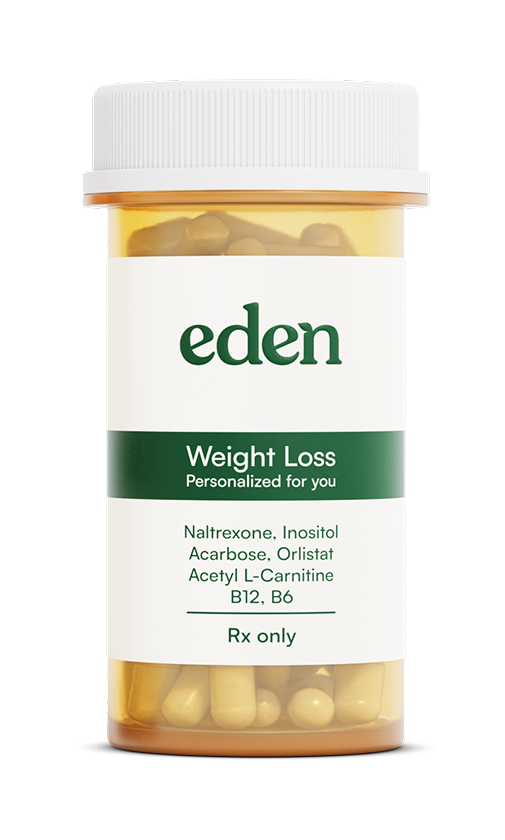Basal Metabolic Rate (BMR): Understanding Your Body’s Calorie Needs and Eden’s BMR Calculator
Are you curious about how many calories your body burns each day at rest? Whether you’re aiming to lose weight, gain muscle, or maintain your current physique, understanding your Basal Metabolic Rate (BMR) can be a game-changer. BMR represents the base number of calories your body needs to keep you alive and functioning while at rest – essentially the energy required for your vital organs to operate (heart beating, lungs breathing, body temperature, etc.). In fact, BMR accounts for roughly 60–70% of the calories an average person burns in a day, making it the largest piece of your daily energy expenditure. In this article, we’ll explain what BMR is, how it’s calculated, how it relates to your Total Daily Energy Expenditure (TDEE), and how you can use Eden’s free BMR Calculator to plan your calorie needs. We’ll also cover how to apply your BMR and TDEE to common goals like weight loss, muscle gain, or simply maintaining a healthy weight. By the end, you’ll see why knowing your BMR provides a useful starting point for nutritional decisions – all with a anonymous, and free tool.
This calorie calculator is intended for informational and educational purposes only. The results are an estimate and are not intended to be a substitute for professional medical advice, diagnosis, or treatment.
What Is Basal Metabolic Rate (BMR)?
Basal Metabolic Rate (BMR) is the number of calories your body needs to perform essential life-sustaining functions while at complete rest. Think of it as the energy you’d burn if you slept or rested all day without any physical activity or eating. These calories fuel critical processes like breathing, circulating blood, controlling body temperature, cell production, brain and nerve function, and all the basic metabolism that keeps you alive. It’s essentially your body’s “idle” energy consumption, similar to how a car uses fuel while idling in park.
BMR is measured under very strict conditions: in a neutrally temperate environment, after about 12 hours of fasting (so that your digestive system is inactive). In these controlled conditions, all of the energy you burn is just to keep your organs functioning. For most people, this basal metabolism constitutes the majority of their daily calorie burn. Studies estimate that about 70% of the calories you burn each day come from BMR (keeping your heart beating, lungs breathing, etc.), whereas roughly 20% comes from physical activity and around 10% from digesting food (the “thermic effect” of eating). In other words, the bulk of your daily calorie needs are determined by your BMR, which is why it’s such an important number for any health or fitness plan.

It’s important to note that BMR is not the same as the total calories you should eat in a day – it only accounts for your body at rest. If you essentially did nothing but lie in bed all day, eating no food, you’d burn calories equal to your BMR. In real life, of course, we move around and we eat, so our actual daily calorie requirements will be higher (more on that when we discuss TDEE). But knowing your BMR gives you a crucial baseline: a minimum calorie threshold needed just to support your basic bodily functions. Consuming fewer calories than your BMR on a long-term basis would be unsafe, because you’d be under-fueling even your essential needs. Instead, BMR serves as a starting point for calculating how much above that baseline you should eat once activity is considered.
How Is BMR Calculated (and What Factors Affect It)?
Directly measuring BMR requires special equipment (like calorimetry chambers or gas analysis masks) in clinical or laboratory settings. Most of us don’t have access to those tests, so instead we estimate BMR using predictive equations. These BMR formulas are based on research that correlates certain personal traits with resting metabolic rate. When you use a BMR calculator, you’ll notice it asks for details like age, sex, weight, and height – that’s because these are key factors that influence your BMR.
Key factors that affect your BMR include:
- Age: BMR tends to decrease with age. Younger people usually have higher metabolic rates, while older individuals burn fewer calories at rest. As we age, we typically lose muscle mass and experience shifts in hormone levels, which can lower BMR.
- Sex: Biological sex influences BMR primarily due to differences in body composition. Men often have a higher BMR than women of the same age and weight because men usually carry more lean muscle mass (and less body fat) on average. The greater muscle content raises the resting calorie burn. (Hormonal differences can also play a role.)
- Weight and Height: The overall size of your body significantly impacts BMR. A larger or heavier individual has more cells and tissue to maintain, which means more calories needed at rest. BMR formulas directly factor in weight and height – generally, the more you weigh or the taller you are, the higher your BMR will be. Simply put, it takes more energy to run a bigger engine.
- Body Composition (Lean Mass): Muscle tissue burns more calories than fat tissue, so the proportion of muscle on your body affects BMR. Someone with higher lean body mass (more muscle and less fat) will have a higher BMR than someone of the same weight who has higher body fat percentage. This is why building muscle through strength training can increase your resting metabolism – each pound of muscle uses a bit more energy to sustain itself. (Note that aerobic exercise itself doesn’t boost BMR unless it contributes to muscle gain; it’s muscle growth from training that raises BMR indirectly.)
- Genetics and Hormones: Your genetic makeup and hormonal balance (such as thyroid hormone levels) also influence BMR. Some people naturally have faster or slower metabolisms. For example, an overactive thyroid gland can raise BMR, while an underactive thyroid can lower it. These factors are highly individual and can cause someone’s BMR to be higher or lower than average for their body size. Genetics can account for some unexplained differences in metabolic rate between people. (While we can’t change our genes, being aware of them is useful – e.g., if you have a condition like hypothyroidism, your true BMR might be lower than the standard equations predict.)
There are other minor factors as well – for instance, environmental temperature (being in a very cold or very hot environment can raise your BMR as your body works to stabilize its core temperature), and diet history (extreme calorie restriction can actually lower your BMR as your body adapts). However, the main drivers are the ones listed above, which are all incorporated into BMR equations either directly or indirectly.
BMR Formulas and Equations
Several scientific equations exist to estimate BMR. All of them use the factors above in various ways. The two most popular BMR formulas used in health and fitness are the Harris–Benedict equation and the Mifflin–St Jeor equation. Both formulas take into account your weight, height, age, and sex, but with slightly different coefficients:
- Harris–Benedict Equation: Originally published in 1919 (and later revised in 1984), this was one of the first widely used BMR formulas. It gives separate equations for men and women. For example, in the revised Harris-Benedict formula, a man’s BMR = 13.397 × weight (kg) + 4.799 × height (cm) – 5.677 × age + 88.362, and a woman’s BMR = 9.247 × weight + 3.098 × height – 4.330 × age + 447.593. (No need to memorize those numbers – BMR calculators will do the math for you!) The Harris–Benedict equation was a breakthrough in its time and is still fairly accurate for many individuals.
- Mifflin–St Jeor Equation: Introduced in 1990, the Mifflin–St Jeor equation has become the modern “gold standard” for BMR estimation. Studies have found that Mifflin–St Jeor tends to predict actual measured BMR more accurately for today’s population than the older Harris–Benedict formula. The Mifflin–St Jeor equations are a bit simpler: for men, BMR = 10 × weight (kg) + 6.25 × height (cm) – 5 × age + 5; for women, BMR = 10 × weight + 6.25 × height – 5 × age – 161. If you compare, you’ll notice both formulas use the same inputs (weight, height, age, sex) but with different multipliers and constants. In practice, the Mifflin–St Jeor formula usually gives a slightly lower BMR number than Harris–Benedict for the same person, and it’s considered more in line with reality for most. Most contemporary BMR calculators (including Eden’s) default to the Mifflin–St Jeor equation because of its proven accuracy.
- Katch–McArdle Formula: There is also a formula that uses lean body mass (i.e. your weight minus fat) to calculate your resting calorie needs. The Katch–McArdle formula is BMR = 370 + 21.6 × Lean Mass (in kg). This formula can be especially useful if you know your body fat percentage; for very lean individuals it may give a more tailored estimate, since it directly accounts for how much muscle you have. In general, Katch–McArdle can be more accurate for people who are relatively lean and aware of their body composition. However, since not everyone knows their exact body fat, the Mifflin–St Jeor equation remains the go-to for most situations. Eden’s BMR Calculator allows you to choose different formulas (including Harris–Benedict or Katch–McArdle) in the settings, but will default to Mifflin–St Jeor for general use.
No matter which equation is used, remember that these formulas give an estimate of your basal metabolism. Research shows that even the best BMR equations can be off by around 10% from your actual measured BMR. That’s normal – each person’s metabolism is a bit unique. So, think of your calculated BMR as a ballpark figure. It’s a very useful starting point for planning, but not a perfect or absolute value. Next, we’ll see how to use this BMR number to figure out your total daily calorie needs.
BMR vs. Total Daily Energy Expenditure (TDEE)
Knowing your BMR is great, but as mentioned, it’s not the amount of calories you burn in a typical day – unless you truly do nothing but rest. In real life, you move around, go to work or school, do chores, maybe exercise, and your body also burns some calories digesting the food you eat. When we factor all that in, we get your Total Daily Energy Expenditure (TDEE). TDEE is the total number of calories you burn in a day from all sources: your basal metabolic functions plus your physical activities plus the process of digestion. In formula terms: TDEE = BMR + Activity Expenditure + Digestive (“Thermic”) Expenditure.
To break it down: imagine your daily calories as a pie chart. The largest slice is usually BMR (often ~70% of the total) which keeps you alive at rest. The next slice is your Activity – all movement from walking around, fidgeting, planned exercise, etc. – which might be ~20% of your daily calories (more if you’re very active, less if you’re sedentary). The final slice is the Thermic Effect of Food (TEF), about ~10% of the calories you burn, which is the energy cost of digesting and processing the food you eat. Together, these components make up your TDEE, which represents the maintenance calories you’d need to eat in order to neither gain nor lose weight.
So how do we determine your TDEE? If you have your BMR from the calculator, the simplest method is to multiply it by an activity factor that corresponds to your lifestyle. Health professionals have defined general categories for activity level with multipliers to estimate TDEE:
- Sedentary (little to no exercise): Multiply BMR by 1.2. (This would be someone with a desk job who doesn’t exercise regularly.)
- Lightly Active (light exercise 1–3 days/week): Multiply BMR by 1.375.
- Moderately Active (moderate exercise 3–5 days/week): Multiply BMR by 1.55.
- Very Active (hard exercise 6–7 days/week): Multiply BMR by 1.725.
- Extra Active (intense daily exercise or physical job): Multiply BMR by 1.9. (This is for very heavy activity, such as training twice a day or doing manual labor plus exercise.)

For example, suppose the BMR calculator estimates you burn 1,500 calories/day at rest. If you exercise about 3 days a week and are otherwise moderately active, you might use the “Moderately Active” factor ~1.55. That would give: 1,500 × 1.55 ≈ 2,325 calories/day as your TDEE, or maintenance level. That’s roughly how many calories you’d need to eat each day to maintain your current weight, given your activity level. If you were completely sedentary, your maintenance might be closer to 1,800 calories (1,500 × 1.2), whereas if you were extremely active, it could be around 2,850 (1,500 × 1.9). These activity multipliers provide a convenient way to go from BMR (a resting number) to a realistic daily calorie target.
Most BMR calculators will also calculate your daily needs when you select an activity level. Eden’s free BMR Calculator, for instance, lets you input your details and then shows your estimated daily calorie requirements for various activity levels – so you can see your BMR and what it translates to if you’re sedentary vs. lightly active, etc. This TDEE estimate is incredibly helpful for planning your diet. Next, let’s see how you can use that information for specific fitness goals.
Using BMR and TDEE for Weight Maintenance, Loss, or Muscle Gain
Once you know your estimated daily calorie needs (TDEE), you can adjust your nutrition depending on your goal. Here’s how BMR and TDEE come into play for maintaining weight, losing weight, or gaining muscle:
- Weight Maintenance: If you want to maintain your current weight, you’ll aim to consume about the same number of calories as your TDEE. This is your caloric balance point – eating roughly the calories you burn each day. For example, if your total daily expenditure is ~2,300 calories, you’d eat approximately 2,300 calories to stay at the same weight. In this state, your body gets enough energy to support both your BMR and activity without needing to tap into stored fat or add new fat. Weight maintenance is all about energy balance: calories in = calories out. Of course, day-to-day fluctuations are normal, but over time if you consistently eat at maintenance, your weight should remain stable.
- Weight Loss (Calorie Deficit): If your goal is fat loss, you need to consume fewer calories than your body burns – this is known as a calorie deficit. By eating below your TDEE, your body will start utilizing stored energy (body fat) to make up the difference, resulting in weight loss. A small to moderate deficit is generally recommended for sustainable and healthy weight loss. Cutting about 500 calories per day is a common guideline, which on average leads to roughly 0.5–1 pound of weight loss per week. (For instance, if your maintenance is 2,300 kcal, you might aim for about 1,800 kcal per day to lose weight at a steady pace.) Even a 300–500 calorie deficit can yield around 0.5 kg (1.1 lb) of weight loss per week for most individuals. This gradual approach helps ensure you’re losing fat while preserving muscle, and it’s easier to stick with than drastic crash diets. It’s not advised to eat extremely below your BMR – remember, your BMR calories are needed for your organs to function. Consuming only your BMR (or less) would likely be too low and not provide enough energy for daily living or health. So, if you’re dieting, base your calorie target on your TDEE minus a reasonable deficit, not BMR alone. Always prioritize proper nutrition even when reducing calories, and consider consulting a healthcare professional if you plan to go on a very low-calorie diet.
- Muscle Gain (Calorie Surplus): If your goal is to gain muscle weight (often called “bulking”), you’ll want to eat more than your TDEE – a calorie surplus. Your body needs extra energy to build new muscle tissue. However, the surplus should be moderate; eating too many extra calories can lead to excessive fat gain. A commonly recommended surplus is on the order of +250 to +500 calories per day above maintenance. For example, if your TDEE is 2,300 kcal, you might start consuming around 2,600–2,800 kcal daily when trying to build muscle. This level of surplus typically yields a weight gain of about 0.25–0.5 kg per week (roughly 0.5–1 lb/week), which is considered a good pace for lean muscle gains. It might not sound like much, but slow and steady is key – the goal is for most of that weight to be muscle, not fat. Gaining much faster (say 1+ kg per week) usually means you’re likely adding fat. Along with a caloric surplus, make sure you’re doing regular strength training and getting adequate protein, so that the extra calories go into muscle growth. Monitoring your weight and body composition over time will help you adjust your calorie intake – if you’re not gaining any weight, you may need a bit more calories; if you’re gaining too much fat, scale the calories back a bit. Everyone’s exact needs differ, but the 250–500 kcal surplus is a useful starting range to tweak from.

Keep in mind that these recommendations (500 kcal deficit for weight loss, 250–500 surplus for muscle gain) are general guidelines. Individual factors – such as your starting body fat %, hormone levels, and genetics – can influence how fast you lose or gain weight. It’s always a good idea to track your progress (body weight changes, how your clothes fit, etc.) and adjust your calorie intake accordingly. But by using your BMR and TDEE as a framework, you’re grounding your plan in a solid understanding of your body’s energy needs.
Eden’s Free BMR Calculator: Anonymous, and Educational
At this point you might be thinking, “Okay, knowing my BMR seems useful – but how do I find out what my BMR is?” That’s where Eden’s free BMR Calculator comes in. We’ve built a simple online tool that anyone can use to get their estimated BMR in a matter of seconds. The calculator uses the Mifflin–St Jeor equation (by default) to compute your BMR based on the information you provide – age, sex, weight, and height – which, as we discussed, are the primary factors determining your basal metabolic rate. You also have the option to select an activity level, and the tool will then show your daily calorie needs (TDEE) for that activity level, so you get the full picture of your maintenance calories.
Why use Eden’s BMR Calculator? First, it’s free – there’s no cost or paywall, and you can use it as often as you like. Second, it’s quick and easy – just input your basic details and get immediate results, without any complicated steps. Third, it’s completely anonymous – we don’t ask for any personally identifiable information like your name or email, and you don’t need to create an account. The goal is purely to provide you with helpful data; we respect your privacy. Because of this anonymity, you can feel comfortable exploring different scenarios (for instance, What if I weighed 10 pounds less? What would my BMR be? What if I become more active?) just to see how those factors influence your numbers. It’s a judgement-free educational tool.
Most importantly, Eden’s BMR Calculator provides a starting point for better nutritional decisions. When you have an estimate of your BMR and TDEE, you can plan your eating with more confidence. For example, if you learn that your maintenance calorie need is around 2,300 kcal/day, and you want to lose weight, you might target about 1,800–1,900 kcal/day and expect a gradual weight loss. If you want to gain muscle, you might aim for around 2,600 kcal/day with a solid weightlifting routine. The calculator gives you a tangible reference number to work with, rather than guessing blindly at how much to eat. It can also inform conversations with nutritionists or trainers – you can share your calculated BMR/TDEE to discuss whether your current diet is aligned with your goals.
Remember, though, that these numbers are estimates, not guarantees. Human metabolism isn’t a fixed, precise engine – there’s about a 26% individual variance in metabolic rates that science still can’t predict. So, use the BMR calculator as an educational guide, then listen to your body and adjust as needed. If the calculator says 2,300 kcal/day to maintain weight but you find you’re gaining weight at that intake, then your personal metabolism might be a bit slower – you’d adjust down accordingly. Likewise, if you’re losing weight faster than expected, you might actually need a bit more food. Think of Eden’s BMR Calculator as a helpful compass pointing you in the right direction. You’ll still need to fine-tune the journey, but you’ll be far better informed about your starting point and route.
Lastly, we want to emphasize that health and nutrition are highly individual. Calculators and formulas provide useful benchmarks, but they can’t account for every aspect of your physiology or lifestyle. Always consider factors like your overall diet quality, sleep, stress, and medical conditions, which also affect your well-being and weight management. If something feels off or you have specific health concerns, it’s wise to consult a healthcare professional.
Disclaimer: Eden’s BMR Calculator (and the information in this article) is intended for educational purposes only. It does not constitute medical advice or personalized nutritional guidance. Every individual is different, and you should consult with a qualified healthcare provider or registered dietitian for advice tailored to your personal health circumstances. Use the calculator as a helpful tool, but always listen to your body and professional guidance when making significant changes to your diet or lifestyle.
By understanding your Basal Metabolic Rate and how it fits into your total daily energy needs, you’ve taken an important step toward informed and effective weight management. Whether you aim to trim down, bulk up, or just stay healthy, knowing your numbers can remove much of the guesswork. Eden’s free BMR Calculator is here to support you on that journey – quickly, anonymously, and at no cost – giving you a solid foundation from which to plan your next steps. Empowered with this knowledge, you can make more mindful decisions about your nutrition and reach your goals in a safe, sustainable way. Happy planning, and remember that consistency and patience are key in any health endeavor! Here’s to a healthier you.



















